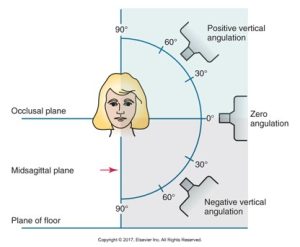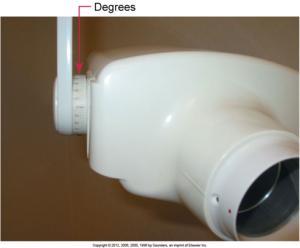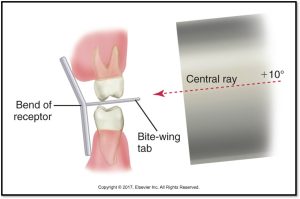21.2
There are different sizes of bite-wing receptors.
| Size 0 | For posterior teeth of children with primary dentitions. |
| Size 2 | For posterior teeth of older children and adults, placed horizontally or vertically. |
| Size 3 | For bite-wings, it is not recommended for adult patients because overlapped contacts often result due to the difference in the curvature of the arch between premolar and molar areas.
Crestal bone may not be adequately seen because of the narrow shape of the receptor. |
Position-Indicating Device Angulation
Angulation is the alignment of the central ray of the x-ray beam in the horizontal and vertical planes. It can be varied by moving the PID in a horizontal or vertical direction and in the bite-wing technique, the angulation of the PID is critical.
Horizontal Angulation
Correct horizontal angulation is when the central ray is directed perpendicular to the curvature of the arch and through the contact areas of the teeth, and incorrect horizontal angulation results in overlapped contact areas.
Vertical Angulation
Vertical angulation is the positioning of the PID in a vertical or up-and-down plane. The positive of this is the PID is positioned above the occlusal plane, and the central ray is directed downward. The negative of this is the PID is positioned below the occlusal plane, and the central ray is directed upward.
All vertical angulations above the occlusal plane are termed positive. Vertical angulations below the occlusal plane are termed negative. Zero angulation is achieved when the position-indicating device (PID) and the central ray are parallel to the floor.
The diagram below displays vertical angulation in dental radiography, showing angles of x-ray projection relative to the occlusal and midsagittal planes of a patient’s head.

Vertical Angulation is measured in degrees on the outside of the tubehead. The image below displays where to find an angle indicator showing degrees for setting vertical angulation.

Below is another image displaying a vertical angulation setup for a bite-wing dental x-ray with a receptor and tab, and the direction of the central ray is +10 degrees.

This is an image displaying negative or incorrect vertical angulation.

Media Attributions
- Iannuci: Dental Radiography, 6th Edition, Chapter 21, CC BY-NC-ND

